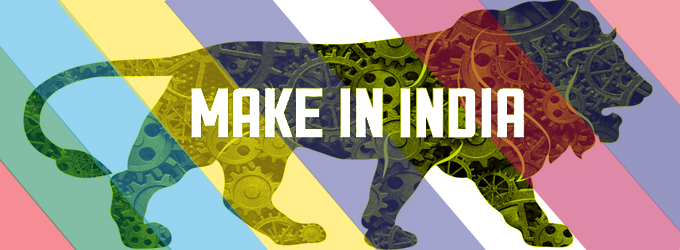|
The Make in India campaign was launched by Prime Minister, Narendra Modi, on 25 September 2014. The ambitious campaign aims at making India a manufacturing hub by guiding investors on all aspects of regulatory and policy issues, as well as obtaining necessary clearances.

Even though India is one of the world’s ten largest economies, India’s manufacturing sector contributes just 16 per cent to the total Gross Domestic Product (GDP). India is ranked 134 out of 189 in the ease of doing business rankings of the World Bank, which is very low as compared to other emerging economies. The Make in India campaign is envisaged with an aim to showcase India as an investor-friendly destination by laying emphasis on key sectors and policy initiatives.
The campaign focuses on 25 sectors which include automobiles, chemicals, IT, pharmaceuticals, textiles, ports, aviation, leather, tourism and hospitality, wellness, railways, auto components, design manufacturing, renewable energy, mining, bio-technology, pharmaceuticals and electronics, among others.
|
|
Ongoing projex in key sectors showcased in 'Make In India'
|
|
Sectors |
Rs. Crore
|
|
Thermal |
2,108,986
|
|
|
|
|
Railways |
|
|
Chemical |
|
|
Mining |
|
|
Ports |
|
|
Electronics |
|
|
Renewable energy |
|
|
Tourism & Hospitality |
|
|
Aviation infrastructure |
|
|
|
|
|
Food Processing |
|
|
Textile |
17,014
|
|
Automobile components |
|
|
|
|
|
|
|
|
*Data as of 31 August 2014 |
|
As per the data available with ProjectsToday, the Automobile sector, including auto components, has ongoing projex worth Rs 59,477 crore as of 30 August, 2014. The Textile sector has projex worth Rs 17,014 crore; Aviation infrastructure Rs 62,805 crore; Ports and Shipping infrastructure Rs 1,89,836; Renewable energy Rs 73,829 and Pharmaceuticals Rs 11,285 etc.
The face of the Make in India campaign is the MakeInIndia.com website which offers information about the key sectors. While the Invest India cell, a joint venture between industry chamber Federation of Indian Chambers of Commerce and Industry (FICCI), the Department of Industrial Promotion and Policy (DIPP) and state governments, will act as a facilitator to foreign investors, guiding them through clearances etc.
As per the campaign, the government will closely monitor all regulatory processes with a view to making them simple and reducing the burden of compliance on investors. A dedicated cell has also been created to answer queries from business entities within 72 hours.
Other bureaucratic initiatives chalked out to make business easier in India include, 24×7 eBiz portal for applying for Industrial License & Industrial Entrepreneur Memorandum (IEM); extension of Industrial license validity to three years; online process for obtaining environmental clearances and self-certification system for all non-risk, non-hazardous businesses etc.
The long term aim is to increase the share of manufacturing in the country’s GDP from 16 per cent to 25 per cent by 2022. And to do this, the ‘Make In India’ campaign aims to attract foreign companies to set up factories in India and invest in the country's infrastructure.
While setting up single window clearance system is a step in the right direction, to sustain the interest of global investors in making India their manufacturing hub, the government would also have to look into issues like taxation, additional impetus to small and medium enterprises, pragmatic changes at the regulatory levels etc. Further, the manufacturing sector cannot prosper in isolation and it will require round-the-clock power supply and modern infrastructure in and around the proposed manufacturing hubs.
|